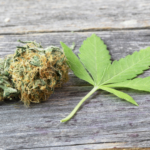Over the course of the last decade, the use of cannabis in women of reproductive age has increased significantly as more states have legalized the recreational and medical use of cannabis. Despite decreasing rates of alcohol and tobacco use during pregnancy, cannabis use during pregnancy is on the rise. In a large study including more than 9,000 pregnant individuals from across the US, researchers have examined the effects of cannabis exposure during pregnancy.
This multicenter observational cohort study was an ancillary analysis of the Nulliparous Pregnancy Outcomes Study: Monitoring Mothers-to-Be (nuMoM2b) in which participants were recruited during the first trimester of pregnancy from eight US medical centers and followed longitudinally throughout pregnancy until the time of delivery. Rather than asking about cannabis use during pregnancy, cannabis exposures were ascertained using a urine drug assay of frozen samples collected during routine obstetric visits. In addition, exposure to nicotine and other drugs were measured using urine immunoassays.
Researchers assessed several different adverse pregnancy outcomes, including small-for-gestational-age birth, preterm birth, stillbirth, and hypertensive disorders of pregnancy.
Cannabis Exposure and Adverse Pregnancy Outcomes
Of the 10,038 participants, 9,257 were eligible for this analysis. Of the 610 participants (6.6%) with cannabis use, 32.4% (n?=?197) had exposure only during the first trimester and 67.6% (n?=?413) had exposure beyond the first trimester.
Adverse pregnancy outcomes were more common in cannabis-exposed pregnancies (25.9%) compared to non-exposed pregnancies (17.4%). The risk for adverse outcomes was higher among those who continued to use cannabis beyond the first trimester (26.7%) compared to those with exposure only during the first trimester (24.1%).
Cannabis exposure at any time during pregnancy was associated with small-for-gestational-age birth (adjusted RR, 1.52; 95% CI, 1.08-2.14). Cannabis exposure was also associated with stillbirth in the unadjusted models; however, this finding was no longer significant after adjusting for potential confounders. Cannabis exposure was not significantly associated with neonatal morbidity or mortality.
The researchers also measured the amount of cannabis metabolites (THC-COOH) in urine samples. Higher THC-COOH levels during the first trimester, as well as higher cumulative estimated cannabis exposure across the pregnancy, were associated with higher likelihood of adverse pregnancy outcomes.
Evidence of Placental Insufficiency
In this multicenter cohort with prospective collection of clinical data, urine samples, and validated survey instruments, cannabis exposure was associated with increased risk of adverse pregnancy outcomes, with the highest risk noted in pregnancies exposed to cannabis beyond the first trimester. This association persisted after adjusting for a number of clinical and sociodemographic factors and when using different modeling approaches. In addition, a dose response was observed where higher cumulative amounts of cannabis metabolites in urine specimens across pregnancy were associated with higher risk of adverse pregnancy outcomes.
While previous studies have shown a link between cannabis use during pregnancy and increased risk of adverse pregnancy outcomes, it has been difficult to estimate the contribution of other factors. More specifically, it has been difficult to determine if concurrent nicotine use (rather than exposure to cannabis) was contributing to or driving risk for adverse outcomes. One of the many strengths of this large prospective study is that it was able to control for a wide array of potential confounders, including exposure to nicotine and other substances. The use of urinalysis to document and quantify exposure to cannabis and other substances, including nicotine metabolites, also eliminated the possibility of underreporting of drug and nicotine exposures.
This study more definitively links cannabis exposure with adverse pregnancy outcomes. The authors speculate that, given the pattern of adverse outcomes seen with cannabis exposure, cannabis may exert its negative effects by compromising placental function, an explanation that is biologically plausible. The endocannabinoid system is active during early pregnancy and is responsible for regulating placental implantation. Although no studies have specifically looked at the impact of cannabis on placental function in humans, chronic cannabis exposure in a nonhuman primate model was associated with visible changes in the placenta consistent with infarction and placental insufficiency. One of the most consistently reported outcomes in cannabis-exposed pregnancies in humans has been suboptimal fetal growth, a finding that is consistent with placental insufficiency.
While multiple studies have raised concerns regarding the use of cannabis during pregnancy, the prevalence of cannabis use in pregnant women continues to rise. The legalization of recreational and medical cannabis in many states has been coupled with perceptions that cannabis is relatively safe.
Given concerns surrounding the known and unknown risks associated with cannabis exposure during pregnancy, professional organizations, including the American College of Obstetricians and Gynecologists (ACOG), have urged greater vigilance, highlighting the importance of screening for cannabis use and educating patients about the risks of cannabis use in women of childbearing age. If cannabis does, in fact, affect placental implantation and function, women should be counseled to abstain from cannabis prior to conception to avoid exposure to cannabis and its metabolites during the earliest stages of pregnancy.
Ruta Nonacs, MD PhD
References
Metz TD, Allshouse AA, McMillin GA, Greene T, Chung JH, Grobman WA, Haas DM, Mercer BM, Parry S, Reddy UM, Saade GR, Simhan HN, Silver RM. Cannabis Exposure and Adverse Pregnancy Outcomes Related to Placental Function. JAMA. 2023 Dec 12;330(22):2191-2199.








Leave A Comment